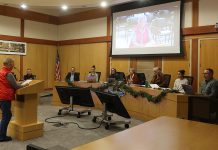Toilet and turf rebates for Healdsburg residents
North county residents will soon be able to take advantage of water conservation programs already available to Windsor and municipalities in central and southern Sonoma County. Over the next few months, high-efficiency toilet installations and grass turf rebates will become available to areas including Healdsburg, Geyserville and Cloverdale.
Sonoma County has partnered with multiple cities and irrigation districts in northern Sonoma County and Mendocino County for the soon-to-launch Sonoma-Mendocino Immediate Drought Relief Project, said Fourth District Supervisor Mike McGuire. Through the partnership, officials hope to ease the burden placed on the upper Russian River, which is witnessing its driest period in the last 300 years.
“The drought relief program has a goal of saving 41 million gallons per year,” McGuire said.
Entities including Sonoma County Public Works, northern Sonoma County cities, the Sonoma County Water Agency, the cities of Ukiah and Fort Bragg, as well as multiple Mendocino County irrigation districts collectively raised over $500,000 to fund the conservation programs. “We then went to the state to petition the Governor’s Office for an additional $1 million, which we recently received,” McGuire said.
With the funding, officials hope to make available water savings programs that are “as simple and inexpensive as possible,” McGuire said. Programs focus on replacing traditional toilets, which use about 1.6 gallons per flush, with high efficiency toilets, which cut water use to .8 gallons, as well as replacing lawns, which have proven, on average, to be households’ most water-thirsty feature, with drought tolerant plants and landscaping.
To reach the ultimate 41 million-gallon savings goal, the program has established smaller targets for each conservation area. Officials intend to see 3800 traditional toilets replaced with high-efficiency toilets and remove 500,000 square feet of lawn, which is the equivalent of 10 football fields, according to McGuire.
The program also proves notable for Sonoma and Mendocino counties’ collaboration on matters related to the drought. “This program is significant, because this is the first time Sonoma and Mendocino counties have come together with a joint water savings program,” McGuire said. “And we’re excited to be partnering with Mendocino County to permanently reduce water consumption, both in home and in the yard.”
Residents interested in learning more about the water savings programs may access two websites that are being established: www.mendodrought.org for Mendocino County residents and www.sonomacountywater.org/drought for Sonoma County residents. There, McGuire said residents can sign up to take part in free high-efficiency toilet upgrades.
“This program is going to cover all costs, from a new toilet, to paying a plumber, to having the old toilet removed,” McGuire said. Officials also encourage licensed, local plumbing contractors to contact the Water Agency to participate in the program.
Residents will also be paid to remove their turf and replace it with drought tolerant landscapes, according to McGuire. A list of licensed landscape contractors will also be available on the program websites.
Toilet and turf-related conservation programs have been successful in other areas of the county, according to McGuire, including Sonoma Valley, where 5,000 toilets were replaced with more water efficient models. “We’re hoping to have the same successful results in northern Sonoma County,” he said.
Cities in northern Sonoma County, including Cloverdale and Geyserville are solely reliant on flows from Lake Mendocino, which as of Aug. 25 sits at 30.4 percent of its water supply capacity. Because the communities are not under the direct purview of the Water Agency, the communities have not yet been able to take part in the conservation programs available to central and southern Sonoma County.
“Northern Sonoma County has been impacted more significantly by this drought crisis than any other corner in Sonoma County because if you are in other parts of the county, you can also rely on Dry Creek water,” McGuire said. Dry Creek flows from Lake Sonoma, which as of Aug. 25 sits at 63.9 percent of its water supply capacity.
“We want to be focused on northern Sonoma County because there has not been a program that has had as much energy or funding behind it in northern Sonoma County in recent history,” McGuire said. “This is going to be the most aggressive drought relief and water savings program that northern Sonoma County has ever seen.”
Officials have also reined in flows from Lake Mendocino to help conserve its dwindling water supply. As of Aug. 25, flows were reduced from 75 cfs to 50 cfs. Officials are also looking at implementing mandatory conservation, as already implemented cities such as Healdsburg and Cloverdale, throughout the county.
The Sonoma-Mendocino Immediate Drought Relief Project launches in September, with installations beginning in October.








